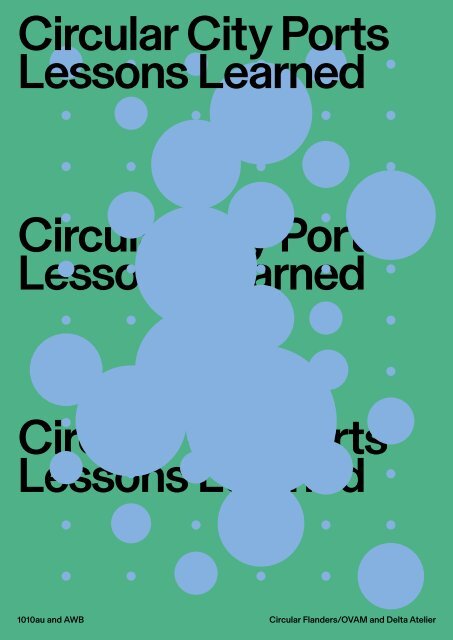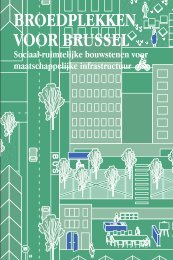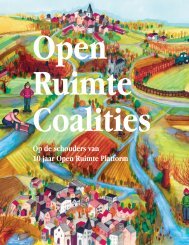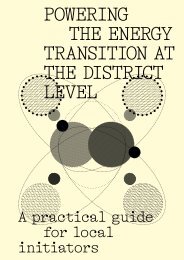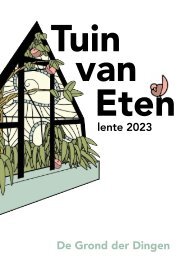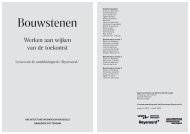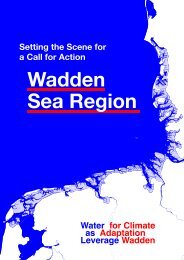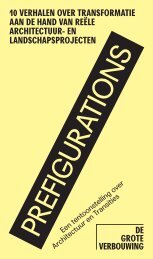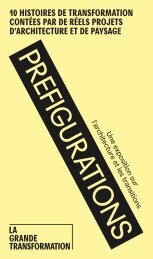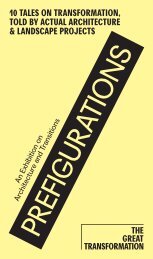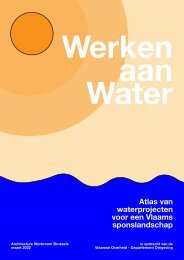Circular City Ports - Lessons Learned
Create successful ePaper yourself
Turn your PDF publications into a flip-book with our unique Google optimized e-Paper software.
<strong>Circular</strong> <strong>City</strong> <strong>Ports</strong><br />
<strong>Lessons</strong> <strong>Learned</strong><br />
<strong>Circular</strong> <strong>City</strong> <strong>Ports</strong><br />
<strong>Lessons</strong> <strong>Learned</strong><br />
<strong>Circular</strong> <strong>City</strong> <strong>Ports</strong><br />
<strong>Lessons</strong> <strong>Learned</strong><br />
1010au and AWB<br />
<strong>Circular</strong> Flanders/OVAM and Delta Atelier
1010au and AWB<br />
<strong>Circular</strong> Flanders/OVAM, Delta Atelier<br />
1010au and AWB<br />
<strong>Circular</strong> Flanders/OVAM, Delta Atelier
Initiator<br />
Delta Atelier<br />
<strong>Circular</strong> Flanders/OVAM<br />
Commissioner<br />
<strong>Circular</strong> Flanders/OVAM<br />
Authors<br />
Architecture Workroom Brussels (AWB)<br />
1010 architecture urbanism (1010au)<br />
Graphic design<br />
Vrints-Kolsteren
Delta Atelier '<strong>Circular</strong> <strong>Ports</strong>' Program<br />
The Delta Atelier positions itself as an<br />
autonomous P2P knowledge and action platform<br />
among more than 50 actors who work in innovative<br />
ways to make the urban landscapes of our joint<br />
Delta, composed by: Netherlands, Flanders,<br />
Brussels and, by extension, the regions of North<br />
Rhine-Westphalia and Nord-Pas-de-Calais. The<br />
platform bundles scattered knowledge and practical<br />
experience about the spatial impact of different<br />
transitions (mobility, energy, water, biodiversity,<br />
circular economy, agriculture, care) and organizes<br />
interaction between peers - both designers and<br />
policy makers and organizations as experts - so<br />
that they learn from each other and jointly formulate<br />
and realize new breakthroughs. The Delta Atelier<br />
sets out a program of debates, workshops, project<br />
initiations, design research, a physical workplace,<br />
exhibitions, virtual exchange (documentaries,<br />
podcast) and a community-driven online exchange<br />
platform.<br />
The Exploratory trajectory on <strong>Circular</strong> <strong>City</strong><br />
<strong>Ports</strong> position itself within the Delta Atelier '<strong>Circular</strong><br />
<strong>Ports</strong>' program. The hypothesis that ports will play a<br />
crucial role in the transition towards more circularity,<br />
is bundled within the Delta Atelier within an agenda<br />
of collective work programs, building new types<br />
of transformation projects from new coalitions.<br />
Within the “<strong>Circular</strong> ports” program, the planning<br />
authorities are working together on a <strong>Circular</strong><br />
Main Frame (scale XL) on the Delta as a whole; a<br />
regional test is being set up around the North Sea<br />
Port based on cooperation between the provinces<br />
of East - and West Flanders and Zeeland (scale L);<br />
exploring the bridge between the port cities and the<br />
ports, the “city ports” (such as Antwerp Eilandje II<br />
or Rotterdam Makers District) as catalysts of a new<br />
manufacturing and circular economy, together with<br />
OVAM / <strong>Circular</strong> Flanders, 1010au and AWB (scale<br />
M); the IABR and the municipality of Rotterdam<br />
together with the port authority are strategizing<br />
around the Rotterdam Makers District within Test<br />
Site M4H, towards the realization of a pilot for a<br />
circular building economy integrated with logistics<br />
functions in the Merwe Vierhavens, experimenting<br />
on the scale of the building typology (Scale S).<br />
These different trajectories, each with their<br />
own coalitions, have met every six months since<br />
their first meeting within the context of the Delta<br />
Atelier, to coordinate their independent tests. The<br />
support that the Delta Atelier offers them in this<br />
regard is in building a constructive narrative for the<br />
future of the Delta: if we start to link things together,<br />
we can actually start designing the desired living<br />
environment.
Image: Heros Sluiskil BV, © AWB
Explorative trajectory '<strong>Circular</strong> <strong>City</strong> <strong>Ports</strong>'<br />
Climate change and the urgent need to move towards<br />
a different economic model, founded upon<br />
diverse understandings of <strong>Circular</strong> Economy, is at<br />
the root of many new collaboration platforms and<br />
policy initiatives. As ports are an key links in the<br />
global supply chain and also a subject of transition,<br />
they can be a leverage to further circularity in their<br />
own space, but also beyond their borders. The port<br />
sight became a central topic during the 2018 IABR,<br />
in the publication “Lage Landen” and in the Delta<br />
Atelier working conference during the summer of<br />
2018. During this last event, circular ports were<br />
approached through four scales, ranging from the<br />
smallest scale of the company, to the city port, the<br />
regional port system, and ending with the Delta<br />
area, as a whole. Different parties saw the value of<br />
8<br />
Image: <strong>Circular</strong> <strong>City</strong> <strong>Ports</strong>: Testsite M4H+ by 1010au on the expo<br />
‘You Are Here’, Brussels © Tim Van de Velde<br />
is a place where there is access to all kind of flows,<br />
They are gateways for both incoming and outgoing<br />
flows. They house a mix of logistical and industrial<br />
activities, which are the big players who need to<br />
shift towards a more circular system of functioning.<br />
Next to that, the ports find themselves in a momentum<br />
of change: when looked at the geopolitical context,<br />
the past globalization impetus seems losing<br />
force: localities find themselves in a quest to decrease<br />
exposure to global volatility and want to anticipate<br />
collapse by boosting their self-sufficiency.<br />
The climate change challenges are globally raising<br />
questions on how our production, functioning and<br />
developing need to have a radical shift, being aware<br />
on how sustainability policy, energy transition, transition<br />
to a post-carbon economy, digitization and<br />
automation will take place in our realities. It all affects<br />
the organization and functioning of ports. It is<br />
hence clear that circularity could definitely find its<br />
roots in these ports in transition.<br />
It is then logic that ports are considered ideal<br />
places to advance the circular transition, in their<br />
role as logistical and industrial hubs but not less as<br />
location for industries that are active in the collection,<br />
treatment and shipment of waste and stimulate<br />
the emergence of innovation circles. This in-<br />
working on these scales and started up different researches<br />
and projects moved by the need to better<br />
grasp the issue at stake. The exploration on <strong>Circular</strong><br />
<strong>City</strong> <strong>Ports</strong> was part of this first round of projects, as<br />
well as the focus of this synthesis document.<br />
That <strong>City</strong> <strong>Ports</strong> have a strategic importance<br />
to further circularity is beyond question. Their location<br />
has a close proximity to both the port and the<br />
city. Cities are the biggest consumers and waste<br />
producers, and keep on attracting an unprecedented<br />
number of people, transforming businesses and<br />
the built environment in the process, mines in all<br />
kind of ways. <strong>Ports</strong> are pins in global supply chains<br />
as source of economic activities , as a gateway and<br />
a crossing point. <strong>City</strong> <strong>Ports</strong> combine the access to<br />
resources with the demand for them, at a scale that<br />
is not the one of Industrial <strong>Ports</strong>, indirectly allowing<br />
for certain degree of experimentation. The <strong>City</strong><br />
<strong>Ports</strong> were the economical core inside the city itself<br />
until the industrial revolution, the fact that <strong>City</strong> <strong>Ports</strong><br />
were ‘left-behind’ by the continuous scaling-up of<br />
maritime activities after WWII, made them in-between<br />
spaces to test out new development models<br />
(from waterfront developments to transitory urbanisms)<br />
and helped to position them in the right place<br />
to initiate now a urban circular transition.
Explorative trajectory '<strong>Circular</strong> <strong>City</strong> <strong>Ports</strong>'<br />
9<br />
The hypothesis of circular city ports was the<br />
starting point of an exploratory trajectory, commissioned<br />
by the Public Waste Agency of Flanders<br />
(OVAM) and <strong>Circular</strong> Flanders (Vlaanderen Circulair).<br />
The team of Architecture Workroom Brussels<br />
(AWB) and 1010 architecture and urbanism (1010au)<br />
took up this challenge. Different circular initiatives<br />
and visions were gathered through a benchmarking<br />
of 11 city ports: Le Havre, Dunkerque, Ostend, North<br />
Sea Port/Ghent, Brussels, Antwerp, Dordrecht,<br />
Rotterdam, Amsterdam, Duisburg and Hamburg. In<br />
some cases, defining a space which could be called<br />
‘<strong>City</strong> Port’ was not always straightforward and thus<br />
the benchmarking also incorporates initiatives in<br />
the Cities and Industrial <strong>Ports</strong>. In other cases, the<br />
<strong>City</strong> Port itself was already a clear project, like ‘Innovative<br />
<strong>City</strong> Port’ (Innovatieve Stadshaven) in Antwerp<br />
or the Makers District in Rotterdam. During<br />
the benchmarking, there was also a search to distinguish<br />
the different aspects of circularity, since it<br />
is clear that there is no one singular way to be circular.<br />
Finding the right language to name things and<br />
activities was therefore also an important aspect of<br />
this exploratory trajectory.<br />
Le Havre<br />
Image: A. Stevens & Co Recycling, Vergotedock in Brussels<br />
© A. Stevens & Co Recycling<br />
Coming at the end of the exploration, different<br />
conclusions could be made, combining the<br />
different challenges and chances that came forward<br />
during the working sessions and the research.<br />
These conclusions want to stress the different actions<br />
that need to be taken, not only at the scale of<br />
Duinkirk<br />
Le Havre<br />
Ostend<br />
Rotterdam<br />
Antwerp<br />
North Sea Port-Ghent<br />
Brussels<br />
Amsterdam<br />
Dordrecht<br />
Hamburg<br />
Duisburg<br />
the city port itself, but also beyond its borders and<br />
on different scales. These actions need to be put on<br />
the agenda of all the different parties involved in the<br />
transition towards circularity in <strong>City</strong> <strong>Ports</strong>, Industrial<br />
<strong>Ports</strong>, Cities, Regions and the Delta as a whole.<br />
Overview of the investigated ports © AWB and 1010au<br />
Next to the benchmarking, interviews were<br />
done to gain a better insight into some initiatives<br />
and to harvest projects and ideas which were not<br />
publicly known. Through a public debate and two<br />
working sessions the gathered knowledge of this<br />
benchmarking and interviews were presented and<br />
formed the basis for thematic working tables. The<br />
different invited stakeholders and interested parties<br />
could talk freely about their issues and chances<br />
in working towards circularity inside <strong>City</strong> <strong>Ports</strong>,<br />
<strong>Ports</strong> and Cities. Each session enriched the ongoing<br />
benchmarking and other research.
Image: Overview of the circular initiatives in fiches during the working session on 2nd of April 2019 © Miles Fischler
Looking at the <strong>City</strong> Port as a<br />
starting point for circularity is vital.<br />
Looking at the <strong>City</strong> Port as a<br />
starting point for circularity is vital.
●<br />
The <strong>City</strong> Port is a crucial<br />
scale to enhance circularity<br />
The position and scale of the <strong>City</strong> Port “in-between”<br />
the city and the port play an important role. The<br />
connection to both the resources and knowledge of<br />
the city and the near presence of the industrial port<br />
with its many processes and logistical functions are<br />
important leverages to boost circularity.<br />
●<br />
The <strong>City</strong> Port is more a mindset,<br />
rather than a spatial site.<br />
The circular <strong>City</strong> Port should be seen as a modus<br />
operandi for testing, reflecting and revisioning.<br />
Practices are challenged to develop new typologies,<br />
tools, collaborations, covenants… Only by<br />
doing and exchanging, we can move towards more<br />
circularity.<br />
●<br />
13<br />
For circularity to get started, you need site<br />
specific experimental projects and a supporting<br />
policy framework<br />
Experimental projects and a supporting policy<br />
framework are crucial to enhance circularity.<br />
Such projects tend to look for “in-between” places<br />
like <strong>City</strong> <strong>Ports</strong>, where there is room, and which<br />
is positioned close to the networks serving the city.<br />
Most of the times, they do require subsidies to erect<br />
infrastructure adapted to their operations. And they<br />
need specific policies that will consolidate their<br />
operations into a different value framework. These<br />
combinations of elements come together in certain<br />
spaces. These places should be the first seeds<br />
inside city ports and the network around the city<br />
ports to implement and start-up circularity.<br />
●<br />
The <strong>City</strong> Port is connected to other<br />
scales and should work in a network.<br />
The role and the functioning of the city port is always<br />
connected to bigger and smaller scales, it<br />
cannot be considered as a stand-alone scale. The<br />
city-port needs to be part of a wider strategy, that<br />
can define circular territorial development. Clear is<br />
the necessity of a scale interrelation in order to constitute<br />
a larger system of collaborations.
On site at Eilandje 2.0 in Antwerp for the project of ‘Innovatieve Stadshaven’ © 1010au
The following eight arguments to further circularity<br />
want to set the agenda for future research and projects.<br />
15<br />
01 We need a more comprehensive understanding of the<br />
many practices and innovations linked to circularity.<br />
02 Port authorities need to rethink their role and business<br />
model in light of circularity.<br />
03 To build up a system of circularity, you need<br />
to set up different ecosystems of actors<br />
04 The current obstacle of data sharing needs to be overcome<br />
to start up a circular strategy using the existing chains.<br />
05 A significant shift in the regulatory framework<br />
is crucial in order to facilitate circularity.<br />
06 The programming of infrastructure is essential to support<br />
the further development of circularity in city ports.<br />
07 A circular port relies on the existence of differentiated<br />
environments to work and thrive.<br />
08 The transition towards more circularity cannot be tackled<br />
alone, but coalitions need to be promoted in order to<br />
strategize upon this change.<br />
The following arguments derive from the exploratory<br />
research we conducted. This research consisted<br />
of a benchmarking analysis, a series of interviews<br />
and workshops with relevant stakeholders. The issues<br />
and possibilities that came to the foreground<br />
could be connected to each other into eight main<br />
arguments analyzed, with each some specific items<br />
that should be on the agenda.
01 We need a more comprehensive understanding of the<br />
many practices and innovations linked to circularity.<br />
01 We need a more comprehensive understanding of the<br />
many practices and innovations linked to circularity.
01 17<br />
●<br />
There are not yet clear definitions of all<br />
aspects related to circularity.<br />
●<br />
<strong>Circular</strong>ity needs to be business driven, and<br />
not only be a political question.<br />
There is not one way to be circular. <strong>Circular</strong>ity and<br />
circular economy are often perceived solely as the<br />
recycling of materials. However, it goes farther than<br />
that. <strong>Circular</strong>ity is already happening inside the ports.<br />
On each scale many projects and initiatives take<br />
place, using and developing different strategies and<br />
innovative ways to start-up a more circular process.<br />
In order to start up a productive dialogue between the<br />
different stakeholders to further circularity, a better<br />
understanding of the diverse circularity approaches<br />
and of their dominant framings is needed. <strong>Circular</strong>ity<br />
can result in very different futures, and we should<br />
acknowledge this heterogeneity and the value<br />
frameworks sustaining them.<br />
●<br />
<strong>Circular</strong>ity asks for innovation, and triggers the<br />
development of new skills and jobs.<br />
Our capacity to further circularity will depend<br />
on innovations in the provision of more-effective<br />
products, processes, services, technologies, or<br />
business models. News skills will be developed, and<br />
new jobs will be required to adopt them. At the <strong>City</strong><br />
Port level, understanding this change might help to<br />
accelerate the adoption (or modification) of circular<br />
processes, and their practical implementation.<br />
The primary focus of circular economy is on the<br />
systemic redesign of our modern industrial system.<br />
This requires a real paradigm shift that cannot be<br />
achieved in isolation.<br />
●<br />
Everybody is inventing the ‘circular wheel’<br />
while the questions and challenges linked to<br />
circularity are common to many companies,<br />
ports and cities.<br />
Knowledge of all the aspects related to circularity<br />
is not openly shared. The lack of a platform from<br />
where this knowledge could be shared is preventing<br />
the system from fully transforming it. Many ports,<br />
cities, regions, villages and companies deal with<br />
the same issues and possibilities, and some of them<br />
know already how to handle them. On the other<br />
hand, there isn’t a single way to be circular, and this<br />
way surely surpasses the mere material recycling to<br />
move into a redefined industrial system, operating<br />
within planetary boundaries and vigilant of<br />
everyone’s welfare. The challenge it to share these<br />
innovations while staying true to the wide range of<br />
circular framings.<br />
●<br />
The win-win of circularity is not yet clear<br />
to companies.<br />
Currently the benefits of circularity inside businesses<br />
are not yet counted inside the business models and<br />
plans. To convince the companies to invest in circular<br />
innovations and in collaborations, they need to be<br />
made aware of the advantages that come with these<br />
investments. There should be a clear view on the<br />
return of this investment and on the gain on other<br />
levels: reduction of energy costs, less production or<br />
material costs, creation of new jobs… Implementing<br />
circularity inside business models should be seen<br />
as a must-do for each company, and not something<br />
that has been unwillingly imposed by higher<br />
authorities. The beneficial side of circularity should<br />
be investigated and shared in order achieve this shift.
01 Imagining new jobs in the<br />
Rotterdam Makers’ District<br />
M4H+ by 1010au<br />
18<br />
<strong>Circular</strong>ity leaves behind a trail of things and<br />
performances. All recycling starts in a container<br />
and relies on a sequence of meticulous actions.<br />
These are at present deemed superfluous. Instead,<br />
they could result in a unique set of crafts. Because<br />
circularity aims at designing out wastes and closing<br />
loops, it needs to be fit with industrial practices that<br />
depend on concrete staff and places. The following<br />
jobs are part of a research study, focusing around<br />
three flows, relevant for M4H: construction, textile<br />
and agri-food. Some examples of jobs are presented<br />
here. The gate-keeper supervises the traffic and the<br />
flows of organic waste, and oversees coalitions and<br />
transactions among actors. The clairvoyant keeps<br />
overview of the total organic value chain and looks<br />
into the future for new opportunities and resources.<br />
01 Imagining new jobs in the<br />
Rotterdam Makers’ District<br />
M4H+ by 1010au<br />
In the case of textiles, sorting includes the<br />
recognition and accurate placement of material, but<br />
sometimes also the removal of accessories such as<br />
buttons or zippers. The remover can take up this<br />
role. The deconstruction orchestrator organizes<br />
the deconstruction of built structures; cares for the<br />
sorting, storage and transport of salvaged materials<br />
and components.
The clairvoyant<br />
THE CLAIRVOYANT<br />
The gate-keeper<br />
THE GATE-KEEPER<br />
The deconstruction orchestrator<br />
THE DECONSTRUCTION ORCHESTRATOR<br />
The remover<br />
THE REMOVER
02 Port authorities need to rethink their role<br />
and business model in light of circularity.<br />
02 Port authorities need to rethink their role<br />
and business model in light of circularity.
02 21<br />
●<br />
Port authorities need to move<br />
beyond their role of landlord.<br />
While port authorities are assigned a landlord role<br />
that secure their license to operate, they often<br />
provide services that are of strategic character and<br />
strongly linked to the financial performance (e.g.,<br />
return on investment) of the port as such.<br />
Today, the port authority is forced to be more than a<br />
landlord, moving away from the old port covenants<br />
based on revenues from concessions and tax on<br />
throughput and invest in port community systems<br />
and in hinterland nodes and links. The port authority<br />
needs to become more proactive, adopting a<br />
role as facilitator and community-builder. While<br />
coordination of the port area on a larger scale,<br />
involving corridors, is needed too. This changed<br />
role is crucial in order to promote port efficiencies<br />
through innovations and new governance forms<br />
beneficial to the integration of ports and cities..<br />
●<br />
Enhancing circularity in ports<br />
requires new business models.<br />
The business model describes the way organizations<br />
create, deliver and capture value. When developing<br />
the business model ports need to consider both the<br />
operations and the environment in which a company<br />
exists or will operate. Nowadays, the inflow of cash<br />
of ports come from the taxes on cargo flows and the<br />
concessions that they give to the companies. With<br />
the circular economy transition, port authorities<br />
realize they will need new kind of sources. Cargo<br />
flows will still be there, but probably in a different<br />
volume and handling style than today is the case.<br />
While concessions are often focused on the longterm,<br />
freedom and space to experiment with startups<br />
and other pilot circular projects is equally<br />
needed. Next to these changed cash inflows, the<br />
port authorities are also look for new sources of<br />
income, mostly by diversifying their activities and<br />
roles, ranging from operator to landlord, conservator,<br />
regulator, trade facilitator, cluster leader, regional<br />
development agency and entrepreneur.<br />
●<br />
The vision of the Port should focus<br />
on the long-term, but with a clear<br />
build-up of where to start.<br />
Since port authorities are facilitators, they have<br />
the power to steer companies in a certain way.<br />
With the making of a vision for the Port as a whole,<br />
which focuses on the long-term development and<br />
evolution, companies know where to invest in light<br />
of sustainability and circularity. It is important to<br />
note that with the constitution of a vision, there is<br />
the need to bridge the gap between the vision itself<br />
and the daily operations of the ports and cities. The<br />
vision should give the tools to the local actors to<br />
translate it into feasible projects and steps forward.<br />
●<br />
There is a need for a dialogue between the Port<br />
and Public and Private Actors to know and act<br />
on new and existing circular initiatives.<br />
Currently, port authorities and the community of<br />
port companies are two separate entities, who in<br />
many cases do not communicate. This makes it hard<br />
to act upon the different initiatives that already take<br />
place or want to start up. Port authorities and other<br />
actors involved with the Port should find a neutral<br />
space or platform where they can freely share<br />
their activities, potentialities and issues and which<br />
can serve as a common ground where they can<br />
collaborate. The port authority could also function<br />
more as a facilitator to initiate this dialogue.
02 Criteria for concessions<br />
Survey by European Sea <strong>Ports</strong> Organization<br />
22<br />
‘A survey commissioned by the European Sea<br />
<strong>Ports</strong> Organization (ESPO) and including 43 recent<br />
terminal awarding cases across Europe showed that<br />
environmental issues do not play an important role<br />
in terminal awarding processes across European<br />
ports.’ - Sustainability-Notteboom and Lam-Green<br />
concession (2018). Indeed, the main factors for<br />
awarding concessions here are throughput and<br />
price bid.<br />
02 Duration of concessions Survey by European Sea <strong>Ports</strong> Organization<br />
‘A survey commissioned by the European Sea <strong>Ports</strong><br />
Organization (ESPO) showed that smaller plot<br />
sizes mean a smaller time period or duration of the<br />
concession.’ - Sustainability-Notteboom and Lam-<br />
Green concession (2018).
Criteria considered in the final awarding stage of the terminal<br />
The criterion whit a rank value ‘1’ is the criterion with highest importance<br />
when awaring a terminal. The lower the rank, the lower the importance<br />
● Rank 1 ● Rank 2 ● Rank 3 ● Rank 4 or 5<br />
● Rank 6, 7 or 8 ● Criterion is not considered<br />
0% 10% 20% 30% 40% 50% 60% 70% 80% 90% 100%<br />
Contribution to employment in the region/country<br />
Contribution to the economic development of the region/country<br />
Factors related to the intra-port competition in the port<br />
Wheter the candidate is an incumbent firm or not<br />
Financial proposal, others then the price bid<br />
Technical proposal ror the terminal<br />
Expected thoughput on the termonal<br />
Price bid<br />
Fig. 1 Survey results on the duration of terminal award ● +40 ● 31–40 ● 21– 30 ● 11–20 ● -10<br />
100%<br />
90%<br />
80%<br />
70%<br />
60%<br />
50%<br />
40%<br />
30%<br />
20%<br />
10%<br />
All < 50ha 50–100ha >100ha<br />
Share in total number of projects<br />
Size of the terminal concession (in hectare)
03 To build up a system of circularity, you need to<br />
set up different ecosystems of actors.<br />
03 To build up a system of circularity, you need to<br />
set up different ecosystems of actors.
03 25<br />
●<br />
In each (<strong>City</strong>) Port there should be space<br />
for both new circular actors and for<br />
old actors who will reinvent themselves.<br />
Going towards circularity will ask involved actors<br />
to change in two ways: first, circularity asks for<br />
different technologies, jobs, skills and ideas and thus<br />
new actors who are willing to start-up new initiatives,<br />
experimenting towards more and better circularity.<br />
Secondly, there are also many existing actors,<br />
who see themselves in need for or who are pushed<br />
towards the circular transition. To reinvent these ‘old’<br />
industries, needs as well new kind of processes,<br />
activities, technologies, jobs and skills, but looking<br />
mostly internally to fit these inside the existing<br />
dynamics. Both ways of changing ask for different<br />
kinds of support, experimentation space, vision,<br />
infrastructure… It is possible to estimate that the<br />
balance between these actors would be 30% of new<br />
actors initiating new practices and 70% of existing<br />
actors in need to reinvent themselves.<br />
●<br />
Existing ecosystems should be mapped,<br />
gathering the local knowledge on its<br />
functioning.<br />
There are already certain ecosystems which are<br />
circular, functioning in an efficient way. It is important<br />
that these systems are mapped and comprehended<br />
in order to be able to act on them. Having a profound<br />
knowledge of what is already happening locally, of<br />
which are the dynamics taking place, is important<br />
in order to see the missing links to become more<br />
circular and to learn from already existing practices<br />
that are already enhancing circularity in different and<br />
innovative ways.<br />
●<br />
The clustering of certain actors should<br />
be only in regard of enhancing circularity.<br />
The spaces which are still free inside port and city<br />
areas should be filled in according to a circular logic.<br />
The clustering of actors on these spaces has to be<br />
in regard of what activities are already there – and<br />
which will stay – and what activities the port authority<br />
wants to attract, based on their vision. Different<br />
scenarios could occur. First, there can be a vacant<br />
area, which gives a lot of space for different testing<br />
sites and where new companies could position<br />
themselves. Secondly, it can be a key production<br />
company, where related experimentation sites are<br />
clustered around this main activity. This clustering<br />
of activities and actors should focus on the benefits<br />
that each of them can achieve: exchange of materials<br />
and side products, specific shared regulations<br />
and concessions, collaborations and knowledge<br />
exchange.<br />
●<br />
It is necessary to look beyond the<br />
port-centric supply chains, understanding<br />
the different links and dependencies<br />
between actors<br />
The challenge is that many supply chains are not<br />
port-centric, so the ability of port authorities to act<br />
as research partners will be hindered if terminal<br />
managers, shipping lines and traders are unwilling<br />
to share their data. Transition to circularity depends<br />
on this broader knowledge on actor’s interrelation<br />
and interdependency.<br />
●<br />
Every port should invest in test-sites,<br />
where experiments can take place, and<br />
which attracts certain (missing) actors.<br />
Certain spaces for experimentation need to be<br />
foreseen in ports. These spaces for testing should<br />
handle a differentiated system of concessions and<br />
regulations in order to attract the missing actors or<br />
to support the existing ones. Concessions are often<br />
too strict and envision a long-term commitment of a<br />
company. Regulations are often not flexible enough<br />
to facilitate experiments. In order to invest in testsites,<br />
concessions and regulations need to be based<br />
on an alternative framework which makes the base<br />
to boost experiment.
03 40 recommendations to accelerate the<br />
transition to circular economy<br />
by SERV<br />
26<br />
The Social and Economic Council of Flanders<br />
(SERV) brings Flemish employers and employees<br />
together for consultation and advice on a wide<br />
range of topics. In order to accelerate the transition<br />
to circular economy, the Flemish social partners<br />
have drawn up a policy agenda in the SERV with<br />
40 concrete recommendations. These are grouped<br />
according to four themes:<br />
Encourage and accelerate circular flows,<br />
Stimulate circular enterprises,<br />
Prepare the labor market,<br />
Increase support.<br />
03 Urban metabolism as a tool to activate<br />
circular economy in the BUDA area<br />
By ULB, Ecole Polytechnique de Bruxelles, BATir,<br />
OVAM<br />
Buda, a part of the Port of Brussels, extends over 2<br />
regions and 3 municipalities, each with their own<br />
planning framework and ambitions. Due to this<br />
political fragmentation, less attention was given to<br />
this area and was considered too long as a backside<br />
of the city. However, there are great opportunities<br />
in the existing activities and the area to create an<br />
attractive, economically resilient and circular place.<br />
Under T.OP Noordrand, actors are sitting around<br />
the table, working towards optimization through<br />
concrete projects and discussion tables. A mapping<br />
of these existing actors and their activities has been<br />
done as a base to investigate the territorial circular<br />
area development, as visible on the next page.
Governance<br />
Draagvlak vergroten<br />
Circulaire stromen<br />
aanmoedigen en versnellen<br />
Arbeidsmarkt<br />
klaarstomen<br />
Circulair ondernemen<br />
stimuleren
04 The current obstacle of data sharing needs to<br />
be overcome to start up a circular strategy<br />
using the existing chains.<br />
04 The current obstacle of data sharing needs to<br />
be overcome to start up a circular strategy<br />
using the existing chains.
04<br />
29<br />
●<br />
There is an urgent call for the sharing of<br />
specific data, that could allow us to move<br />
towards new ways of valorizing underused<br />
flows and to build up new circular coalitions.<br />
●<br />
There should be an understanding of the right<br />
scale, crossing different borders, in which the<br />
sharing of data is bringing benefit to all the<br />
parties involved.<br />
The more knowledge is available about certain<br />
material flows, collaboration and processes, the<br />
easier will be to be integrated in certain chains in<br />
order to make it more circular. It is important to note<br />
that the sharing of data should inform on different<br />
aspects of the flows. The data has to mention the<br />
quantitative aspect of the flow and the physical<br />
pathway it follows: how many materials flows from<br />
which location to which location and in which are<br />
the means used to move it? Next to this, initiatives<br />
who handle these flows should also mention the<br />
skills and technical innovation that are required to<br />
manage the flow and the certain knowledge that<br />
comes with it. Thus, data sharing should be both<br />
quantitative and qualitative.<br />
●<br />
The sharing of data calls for a mental shift at<br />
the company level to surpass the competition<br />
between them.<br />
Company competition is not enhancing collaboration<br />
and the sharing of data between different actors<br />
located in the same port area. Therefore, it is crucial<br />
to trigger a mental shift, in order to build up a better<br />
collaboration. Surpassing the company’s competition<br />
by providing a neutral platform or in-between figure<br />
is only one part of the solution.<br />
Borders in all kind are often limiting the sharing<br />
of data and the movement of materials flows and<br />
consequently, the collaboration between different<br />
parties. Waste which crosses the border is already<br />
a difficult topic to incorporate in the policies. A more<br />
flexible stance towards cross border collaborations<br />
is needed. Different regions should be able to work<br />
together, both on the political level, and at the<br />
companies level, enhancing the exchange of flows<br />
and data.<br />
●<br />
Efficient and valuable data sharing calls for<br />
the constitution of a new kind of ‘in-between’<br />
figure, who is both matchmaker as a neutral<br />
person of trust.<br />
A matchmaker could have two pivotal roles: the first<br />
role is to be a neutral body, which can surpass the<br />
competition issue between companies, by being<br />
a trustful ‘in-between’ person. The second role is<br />
to make the known data valuable and efficient:<br />
the matchmaker should look for the best circular<br />
collaborations, bringing these initiatives at the table,<br />
aiming to make the connection available.<br />
●<br />
Next to the data of economical process, the<br />
data of the cities’ flows is also important, with<br />
the public authorities who have the power to<br />
initiate this process.<br />
While circularity is often perceived as dealing with<br />
the material flows of industries, the flows of the city<br />
are not yet fully valued. They are, however, a source<br />
of specific materials of which the circular economy<br />
can profit. Collecting the information on these flows<br />
and finding ways to incorporate it in existing or<br />
new circular ecosystems, could play a crucial role<br />
in enhancing circularity. The city port could be the<br />
strategic place where these ecosystems, which are<br />
often already localized in the industrial zone, can<br />
integrate with these new flows and where they can<br />
be managed, used and recycled.
04 Overview of the material flows of Rotterdam<br />
in 2015<br />
Study ‘Circulair Rotterdam’ by Metabolic<br />
and Circle Economy<br />
30<br />
Quantified studies on the metabolism of urban areas<br />
give val¬uable insights. This study of Metabolic and<br />
Circle Economy is one of them: four flows or sectors<br />
have been chosen for its environmental impact and<br />
potential for job creation (construction, agri-food,<br />
healthcare and consumption goods). Beside the<br />
quantitative research, a collaborative session was<br />
done with companies and stakeholders from each<br />
sector. Here, possible projects were discussed for<br />
their feasibility and bene¬fit-cost calculation were<br />
made. However, the challenge remains; how to give<br />
access to data, that allows actors to move towards<br />
more circularity?<br />
04 Business-to-business relationships visible<br />
at a glance<br />
Toile Industrielle in Dunkirk<br />
This flow diagram shows the interdependence of<br />
companies and the extent of their local roots. This<br />
approach has a twofold advantage: to identify<br />
the potential of territorial development, and to<br />
anticipate the impacts of changes on economic<br />
markets. Thus, it supports political and economic<br />
decisions by representing simulations of impacts<br />
on local industrial ecosystems. And it also makes<br />
possible to visualize at a glance the opportunities<br />
to be seized in a territory and to see Dunkirk as a<br />
favorable breeding ground. This prospective tool<br />
encourages the development of new subsidiaries<br />
such as industrial ecology.
8<br />
MANAGEMENT SAMENVATTING<br />
OVERZICHT VAN STOFSTROMEN DOOR ROTTERDAM 2015<br />
MANAGEMENT SAMENVATTING 9<br />
31<br />
ENERGIE<br />
ENERGIE<br />
Elektriciteit<br />
(9.600 TJ)<br />
Energiegebruik andere sectoren<br />
(38.000 TJ)<br />
Gas en Warmte<br />
(25.000 TJ)<br />
5% Hernieuwbaar<br />
Brandstoffen<br />
(16.000 TJ)<br />
EMISSIES 1<br />
CO 2 uitstoot (4.040.000 ton)*<br />
AGRIFOOD<br />
Gewassen (150.200 ton)<br />
Dierlijke producten (117.000 ton)<br />
Dranken (95.200 ton)<br />
Water (3.748.600 m 3 )<br />
CONSUMPTIEGOEDEREN<br />
Brandstoffen (11.160 TJ)<br />
Papier/karton (45.200 ton)<br />
Onbekend (359.000 ton)<br />
Kunststof verpakkingen (11.300 ton)<br />
Textiel (5.950 ton)<br />
Metalen (8.000 ton)<br />
Verpakkingsglas (18.300 ton)<br />
BOUW<br />
Energie (60 TJ)<br />
Metalen (9.200 ton)<br />
Kunststoffen (500 ton)<br />
Glas (1.400 ton)<br />
Beton (225.000 ton)<br />
Bakstenen (81.900 ton)<br />
Keramiek (27.300 ton)<br />
Andere mineralen (530 ton)<br />
Water (74.200 m 3 )<br />
BIOBASED<br />
MATERIALEN<br />
Gewassen<br />
(150.200 ton)<br />
Dierlijke producten<br />
(117.000 ton)<br />
Dranken<br />
(95.200 ton)<br />
Karton/papier<br />
(45.200 ton)<br />
Hout (7.600 ton)<br />
Textiel (2.390 ton)<br />
NIET-BIOBASED<br />
MATERIALEN<br />
K. verpakkingen<br />
(11.300 ton)<br />
Synthetisch textiel<br />
(3.570 ton)<br />
Metalen (17.200 ton)<br />
Andere kunststof<br />
(1.085 ton)<br />
Chemicaliën<br />
(1.030 ton)<br />
MINERALEN<br />
Glas<br />
(19.700 ton)<br />
Beton<br />
(225.000 ton)<br />
Bakstenen<br />
(81.900 ton)<br />
Keramiek<br />
(27.300 ton)<br />
Andere mineralen<br />
(530 ton)<br />
ROTTERDAM<br />
ORGANISCH AFVAL<br />
(165.080 TON)<br />
OVERIGE MATERIALEN<br />
Karton/papier (37.750 ton)<br />
Hout (25.980 ton)<br />
Metalen (25.720 ton)<br />
Kunststof verpakkingen (25.020 ton)<br />
Andere kunststoffen (13.270 ton)<br />
Textiel (9.510 ton)<br />
Luiers (8.100 ton)<br />
Overige (5.370 ton)<br />
Drankkarton (3.190 ton)<br />
E-waste (2.680 ton)<br />
GEMENGD AFVAL<br />
Grof huishoudelijk afval (19.830 ton)<br />
Overig gemengd afval (63.900 ton)<br />
MINERALEN<br />
Glas (23.800 ton)<br />
Overige mineralen (35.580 ton)<br />
Steenachtig puin (338.150 ton)<br />
BIOGAS (1.040 TON)<br />
COMPOST<br />
(9.100 TON)<br />
NUTTIGE TOEPASSING<br />
(79.400 TON)<br />
Metalen<br />
(6.676 ton)<br />
GERECYCLED<br />
(111.400 TON)<br />
VERBRANDING MET<br />
ENERGIE-TERUGWINNING<br />
(258.800 TON)<br />
VERBRANDING ZONDER<br />
ENERGIETERUGWINNING<br />
(300 TON)<br />
STORTEN<br />
(14.200 TON)<br />
DOWNCYCLEN<br />
(334.800 TON)<br />
ZIEKENHUIZEN<br />
Energie (1.370 TJ)<br />
Textiel (02 ton)<br />
Kunststoffen (1.085 ton)<br />
Chemicaliën (1.030 ton)<br />
Water (986.500 m 3 )<br />
LEGENDA:<br />
onder 3.000 ton/<br />
1.200 MJ/ 10.000.000 m 3<br />
*geschaald naar .5%<br />
WATER<br />
Drinkwater<br />
(58.082.000 m 3 )<br />
Regenwater<br />
(691.860.000 m 3 )<br />
WATER<br />
Rioolwater (383.815.000 ton)<br />
Grondwater (366.122.000 ton)<br />
GELOOSD<br />
(749.937.000)<br />
1 Exclusief industrie en professionele scheepvaart<br />
CIRCULAIR ROTTERDAM
05 A significant shift in the regulatory framework<br />
is crucial in order to facilitate circularity.<br />
05 A significant shift in the regulatory framework<br />
is crucial in order to facilitate circularity.
05<br />
●<br />
To enhance circularity, a certain degree of<br />
flexibility regarding planning tools is required.<br />
Transition toward a more circular functioning of<br />
the industrials systems of the (city) <strong>Ports</strong> requires<br />
spatial flexibility, in order to give the freedom to<br />
companies at the local level to experiment and find<br />
their own way to build up a new circular system.<br />
Therefore, the right planning tools should be in use,<br />
giving differentiated permission in relation with<br />
actors in transition and new actors. There is the<br />
need to develop tools that are allowing innovation<br />
and diversification to take place, that are letting<br />
experimentation happen at the local level, initiating<br />
processes of transition, integrating new functions,<br />
new actors and new collaborations.<br />
●<br />
The definition of concessions has to change<br />
into a tailormade modus operandi.<br />
The standardized concession models taking place<br />
in many <strong>Ports</strong>, is limiting the evolution toward a<br />
more circular system. In this phase of transition, and<br />
within the future vision of a more circular functioning<br />
of ports, concessions are key in order to strategize<br />
upon circular economy. The diversification of<br />
concessions could represent a strategic tool,<br />
enhancing a comprehensive spatial strategy. Some<br />
of the port authority already stated a “monitoring”<br />
phase in order to understand the specific needs<br />
that specific actors and productions have. The<br />
concession system has to be open to the growing<br />
need of companies to experiment and to change,<br />
taking into account also the close proximity to the<br />
city, which represent a key aspect in the building up<br />
of the functioning strategy of each port.<br />
●<br />
Since legislation on circularity is often founded<br />
on a higher level than the region, an institution<br />
on supra-regional level should be formed in<br />
order to connect the different scales and to<br />
cross all kinds of borders.<br />
Port and city authorities and companies have to<br />
deal often with legislation which is formed on a<br />
higher level and on which they don’t have any grip.<br />
From this prospective, it is possible to highlight<br />
a gap between the legislative framework at the<br />
higher level about circularity, and the actions and<br />
decision-making process at the local level. The<br />
supra-regional institutions could represent the inbetween<br />
figure that is coordinating the exchange<br />
between the local and the broader level, compiling<br />
knowledge available on companies and economic<br />
actors, fostering synergies on specific location or<br />
regarding flows, having the role of a neutral match<br />
maker.<br />
●<br />
33<br />
A shared vision needs to be build up between<br />
the different parties, in which their own voices<br />
are integrated in the common values and<br />
objectives.<br />
Opening a dialogue between parties could be a<br />
crucial first step to start collaborations, that’s in this<br />
exact moment is lacking especially at the local level.<br />
Building up exchanges can represent a way in which<br />
different voice can be listened, constituting a shared<br />
vision and objectives. This could be an attempt to<br />
start to build a common ground in which priorities<br />
of different parties of different level come together,<br />
integrating them in order to build a common strategy<br />
for a more circular system in order to lead also the<br />
decision-making process.
05 Providing a framework and space for<br />
entrepreneurs to test, develop and launch<br />
new technologies<br />
Prodock in Amsterdam<br />
34<br />
Prodock is the innovation hub of the Amsterdam<br />
port where entrepreneurs, both growing and<br />
established, can develop and roll out their products<br />
and processes. Prodock offers 4000m2 industrial<br />
workshop, office and outdoor space where, in a ‘plug<br />
& play’ way, can be rented. The port of Amsterdam<br />
is rather isolated from the city and industrial in scale<br />
and activities... Offering space and facilities for<br />
testing attracts new kinds of entrepreneurs that can<br />
foster new synergies and symbiosis between port<br />
and city.<br />
05 Environmental legislation space Port of Amsterdam<br />
A study has been conducted on business sites, along<br />
the West-as of the Amsterdam region, suitable and<br />
necessary for a circular economy. Herein, the port<br />
is of strategic importance: land is scarce and the<br />
economies (of the port) are shifting. Material flows,<br />
crossing the region (also coming from international<br />
networks), can be processed inside the area of the<br />
port, where certain infrastructure is already there.<br />
Now, because of new dynamics inside the port area<br />
(ex. Prodock), a differentiation of various kind of<br />
zones, related to the right environmental space, is<br />
on the agenda. But how does it relate to the ongoing<br />
urbanization (of the port)?
35<br />
Legenda Milieucategoriën<br />
● Milieucategorie 2<br />
● Milieucategorie 3<br />
● Milieucategorie 4-<br />
● Milieucategorie 4+<br />
● Milieucategorie 5<br />
● Milieucategorie 6<br />
● Onbekend<br />
Vb.<br />
Milieucategorie 4:<br />
bierbrouwerij,<br />
betonfabriek, gipsfabriek.<br />
Milieucategorie 5:<br />
cementfabriek,<br />
vervaardiging<br />
industriegas, ruwijzer en<br />
staalfabriek.<br />
Milieucategorie 6:<br />
olieraffinaderij,<br />
koolelektrodenfabriek,<br />
ruwijzer- en staalfabriek.<br />
0 2,5 5 7,5 10km
06 The programming of infrastructure is essential<br />
to support the further development of<br />
circularity in city ports.<br />
06 The programming of infrastructure is essential<br />
to support the further development of<br />
circularity in city ports.
06<br />
37<br />
●<br />
The transition towards circular ports asks for a<br />
different kind of logistic modality, which calls<br />
for specific infrastructure.<br />
●<br />
Investments in the reuse of old infrastructure<br />
should be encouraged to shift to a more<br />
sustainable and multimodal way.<br />
The notion that logistics will disappear, when the<br />
economy evolves from global to circular, is not true. A<br />
different kind of logistics will happen, which is more<br />
focussed on reducing transport needs, travelled<br />
distances and intermediaries, enhancing the usage<br />
of local flows, last-mile logistics and return logistics.<br />
It is about closing different kind of loops starting<br />
from the local level, and strategizing upon different<br />
scale. These dynamics requires new ways of looking<br />
at logistic modality, intermodal transportation,<br />
transforming the infrastructure integrating them to<br />
an economical context in transition.<br />
●<br />
Experimenting with a combined pallet of<br />
services should provide specific facilities<br />
related to certain needs.<br />
Physical infrastructure on its own are not enough to<br />
support circular system at the local level. Therefore,<br />
it is crucial to strategize upon the interrelation<br />
between infrastructure and a series of service,<br />
necessary to accompany existing actors in transition<br />
together with the attraction of new innovative<br />
actors. It is important to strategize toward a more<br />
comprehensive set of service, that can represent<br />
a way to give growth opportunity; flexible permits<br />
in order to experiment at the local level; tools to<br />
implement the network of actors busy on the same<br />
kind of production or finding complementarity<br />
among them. The port authority in this scenario is<br />
playing the role of an enabler for circular economy,<br />
trying to give a set of differentiated services and<br />
facilities to build up a circular system<br />
The existing infrastructure mostly based on fossil<br />
fuel driven economy, are representing an opportunity<br />
to start a shift toward a more circular system in<br />
ports. the asset of a series of infrastructure already<br />
present in certain areas, create the opportunity to<br />
attract and sustain new innovative actors, starting<br />
a clustering logic, in order to activate local circular<br />
dynamics. Building a series of shared infrastructure<br />
based on what is already there, can somehow,<br />
enhance dynamics of collaboration and interrelation<br />
between different economic parties.<br />
●<br />
Programming the infrastructure calls for a<br />
vision on the hardware and software: the<br />
infrastructure itself and the skills needed to<br />
handle it.<br />
In order to envision the infrastructure that could be<br />
possibly enhance the circular economy at the (<strong>City</strong>)<br />
Port level, is necessary to widen up the concept<br />
of what the infrastructure are and should serve.<br />
Therefore, they are a combination of policies, social<br />
contract, tenders and the physical service. In order<br />
to support circularity, it is necessary to constitute<br />
hard infrastructure and soft infrastructure, and, at<br />
the same time, crucial is the programming of this<br />
infrastructure in order to build a series of facilities<br />
supporting the transition to circularity, linking all the<br />
parts involved, from the company to the policy level.
06 Port Feeder Barge<br />
Hamburg<br />
38<br />
The Port Feeder Barge can be considered a green<br />
logistic innovation, in fact this boat typology will make<br />
the internal container logistics of the Port of Hamburg<br />
more efficient and at the same time significantly<br />
more climate-friendly. This means of transportation<br />
is an alternative through water, for the movements of<br />
the containers between the companies and the port,<br />
that usually are carried out by trucks. In this sense,<br />
this boat can act as a floating terminal, for the bigger<br />
cargo ships that are not able to enter in the port, and<br />
in the same time, it can work as vessels for the inland<br />
water ways, in order to substitute all transportation<br />
by trucks.<br />
06 Blue Line Logistics<br />
Antwerp, Brussels, Amsterdam, Paris<br />
This shipping company has designed and built these<br />
boats, suitable for palletized cargoes. Traditional<br />
inland vessels are not suitable for big bags and<br />
pallets. Thanks to the crane on the boat, there is no<br />
need for large infrastructure on the quay or the cargo<br />
can be driven directly on deck with a forklift (due<br />
to its design as a catamaran, it doesn’t tip). In this<br />
respect the ship can handle a cargo of 300 tons or<br />
200 pallets. With its relatively limited draught is also<br />
very suitable for small waterways.
39
07 A circular port relies on the existence of<br />
differentiated environments to work and thrive.<br />
07 A circular port relies on the existence of<br />
differentiated environments to work and thrive.
07<br />
●<br />
Envisioning a new circular landscape, characterized<br />
by differentiated context of environmental<br />
spaces, urbanity, exchanges and<br />
experimentation.<br />
41<br />
with functions like offices and could afford the higher<br />
rents therein implied. Inside the port area itself,<br />
different physical and functional configurations are<br />
still possible.<br />
Global value chains transform within circularity.<br />
They gather resources, transform them in parts and<br />
products, distribute finished goods to markets, and<br />
finally make these resources available again through<br />
various recycling and reuse strategies. The major<br />
consequence of this evolution is that supply chain<br />
management and manufacturing become closely<br />
embedded, and that access to a wide pool of suppliers<br />
and customers is the new source of competitive<br />
advantage (against cheap input costs). This increased<br />
importance of accessibility forces ports to<br />
better integrate in their hinterlands, accounting for<br />
the diversity of environments that exist in them.<br />
●<br />
Heading from a patchwork to a<br />
network approach<br />
Even the most efficient port will fail to attract business<br />
if other links in the supply chain to which it<br />
belongs are not themselves performing well. Additionally,<br />
efficiency without scale no longer seems<br />
to provide an entry card to direct global trade for<br />
smaller ports. Port corridors seem to partially offset<br />
the scale effect, allowing efficient smaller ports to<br />
co-exist alongside large global gateways and eventually<br />
be integrated within their hinterland. <strong>Ports</strong><br />
not only develop new products and services along<br />
those corridors, but the tendency is also to extend<br />
the geographic space within which these activities<br />
take place: from the local level (the port area) to<br />
the regional level (inland networks) and eventually<br />
to the global level, keeping and maximizing value<br />
within global, regional, national or supply chains.<br />
This brings port authorities to invest in inland terminals<br />
and rail connections, setting up intermodal<br />
services, and developing information platforms that<br />
facilitate inland transport.<br />
●<br />
The diversity of environments along port<br />
corridors works as an asset to further<br />
circularity<br />
Characteristic port environments populate those<br />
corridors, positioning them differently in the face of<br />
circular transition. Certain circular activities require<br />
an industrial context because of the hazards or nuisances<br />
involved, as well as the scale of operations,<br />
while other circular activities profit rather from public<br />
transport accessibility and a certain degree of<br />
environmental laxity, or yet others could be mixed<br />
●<br />
The need to integrate port and urban planning<br />
Port-city coordination mechanisms should be created<br />
to further the integration between cities and<br />
ports in light of circularity. Both city and port are<br />
dynamic complex systems, endowed with a physical<br />
structure that combines infrastructures, facilities,<br />
installations into spatial, social and programmatic<br />
assemblages. On one hand, a more flexible<br />
land-management combined with a specialized<br />
environmental legislation in port areas appears to<br />
keep up with the need of scalability and growth.<br />
However, only when this approach is combined<br />
with a concession policy following up on a spatial<br />
strategy profits are truly reaped for both city and<br />
port. Urban planning, on the other hand, can guide<br />
investments towards the construction of transport<br />
infrastructure, fostering the use of waterways and<br />
increasing intermodality, It can also zone areas for<br />
economic development, provide the right facilities<br />
and therefore strengthen industrial agglomeration,<br />
stimulate the creation of clusters, and attract both<br />
investments and networks of collaboration.<br />
●<br />
The circular transition will not be constrained<br />
to the port itself but will follow corridors and<br />
straddle (political) borders.<br />
The transition towards circularity in some supply<br />
chains goes hand-in-hand with a geographical<br />
scale shift, away from global and towards regional<br />
supply chains. Important differences exist too between<br />
supply chains that handle the same type of<br />
commodities: some fruit supply chains have a clear<br />
international orientation, while others may be regionally<br />
oriented, and the share of recycled textiles<br />
differs not only between products but also within<br />
each product market. As recycling rates and resource<br />
efficiency increase, collection and processing<br />
costs of waste are reduced. All of this leads to a<br />
huge growth in the number of companies focused<br />
on creating value through advancing the circularity<br />
of supply chains, companies that locate on diverse<br />
locations along port corridors in function of their<br />
physical and organizational demands. It seems relevant<br />
to envision a wider strategy at the corridor<br />
scale, aligning the diverse regulation frameworks<br />
and facilitating exchange among the stakeholders<br />
beyond the port.
07 Spatial framework as underlayer for urban<br />
development, towards an innovative<br />
makers economy<br />
M4H, Rotterdam<br />
Inside this 180ha large area port-related activities<br />
that have marked the area so strongly (fruitport) are<br />
gradually moving to other locations further on in the<br />
industrial port. In the wake of this transition, smaller,<br />
more innovative makers have settled here because<br />
of cheap rental costs, low noise or odor nuisance<br />
requirements, good accessibility, ... In this plan,<br />
different zones for companies are drawn, where a<br />
mix of living-working is reserved for only certain<br />
areas, leaving room for larger companies to stay or<br />
settle.<br />
42<br />
07 Kanaalkant Area Manager<br />
Albert Canal, Antwerp<br />
In order to become more circular, a good<br />
understanding of what is there is crucial to<br />
establish new synergies and symbiosis. Trust,<br />
sharing information, and talking the same language<br />
(business-case check-ups) can help in detecting<br />
willing actors, defining next steps and managing<br />
projects towards more symbiosis between housing<br />
and production and more water-bound activities.<br />
The area manager is positioned between policy<br />
and the operational side of the companies. On the<br />
border between government and companies, he<br />
encourages the right organizations to start projects.
43<br />
Dike<br />
Dijk<br />
Makerstreet<br />
Makerstraat<br />
Focal point<br />
Brandpunten<br />
Production c<br />
Productiehove<br />
Harborstreets<br />
Havenstraten<br />
Harborboulevard<br />
Havenboulevard<br />
Intermediate streets<br />
Tussenstraten<br />
Fields<br />
Velden<br />
Tidal Parks<br />
Getijdeparken<br />
Basins<br />
Bekkens<br />
Quay Parks<br />
Kadeparken<br />
HUBs<br />
Hubs<br />
tbeeld op basis van concept ruimtelijk<br />
4H<br />
erk vormt de fysieke basis voor M4H als<br />
trict, een innovatiemilieu dat zich kenmerkt door<br />
maakindustrie, stedelijke voorzieningen, wonen<br />
EN<br />
Possible view of the future on the basis of an outline<br />
a spatial framework for the M4H District<br />
The spatial framework is the physical basis for M4H as a f<br />
Makers District, an innovative environment that features a<br />
manufacturing industry, urban facilities, housing, and cultu
08 The transition towards more circularity cannot<br />
be tackled alone, but coalitions need to be<br />
promoted in order to strategize upon this change.<br />
08 The transition towards more circularity cannot<br />
be tackled alone, but coalitions need to be<br />
promoted in order to strategize upon this change.
08<br />
●<br />
A neutral ground should be constituted in<br />
which dialogue and discussion could take<br />
place in order to learn from each other, to<br />
envision a common strategy and to tackle<br />
common problems together.<br />
The pathway the goes toward circularity is not an<br />
easy one, and it consists in a series of changes<br />
and transitions that are complex. Relevant is, on<br />
one hand, the fact that many parties in transition<br />
are facing the same issue, on the other, the fact<br />
that this lesson learned could be shared and<br />
constituting an important body of knowledge. In<br />
this sense, the constitution of a neutral ground to<br />
envision common strategy could help to build up<br />
a task force that works together toward common<br />
objective.<br />
●<br />
45<br />
A common, open agenda should be built up<br />
to steer towards a unified vision to strategize<br />
upon, between port and city, port and<br />
hinterland, and port to port.<br />
Crucial is to set-up an open agenda in order to<br />
listen at the different voices and having a shared<br />
vision and strategies toward collaboration and<br />
circular economy. Fundamental is to build a vision<br />
that is bridging the port and the city, trying to<br />
tackle common issue; moreover, linking hinterland<br />
and the port in order to enhance collaboration<br />
activate complementary strategies; envisioning<br />
a common open agenda between different ports,<br />
trying to overcome competitions, and look at how<br />
together circular economy can be explored and<br />
activated.<br />
●<br />
Collaboration needs to happen at different<br />
scales at with different parties.<br />
In this process of changes, many different parties<br />
need to play a role. The transition toward circularity<br />
can take place only if there is a movement from<br />
different directions, having as common ground<br />
the same goal. This means that collaboration it is<br />
important at the local level, as first step, but need<br />
to be furthered at different levels.
08 Charter ‘Innovative <strong>City</strong> Port’ By 1010au, David Dooghe and DRIFT<br />
46<br />
The former port area has been transacted to the<br />
<strong>City</strong> of Antwerp, that will develop and restructure<br />
the area. Part of ‘t’ Eilandje’, the second phase will<br />
not allow housing development, but focuses on new<br />
urban and port related economies. In this context<br />
a charter was proposed, as the framework of this<br />
new collaborations between companies, authorities<br />
and 3rd parties like OVAM, federations, knowledge<br />
institutes, economical networks... The charter (as<br />
idea) will form a guideline for the development of the<br />
city port area and constitutes the common vision<br />
between these parties.<br />
08 West practice: making the link between<br />
people in the neighborhood and job demands<br />
in the city port<br />
M4H and Bospolder-Tussendijk, Rotterdam<br />
West Practice is a network of cooperating local<br />
organizations that offer programs for talent<br />
development and education for 21st century skills,<br />
with the goal to strengthen the socio-economic<br />
resilience of its inhabitants. Beside educating,<br />
mapping and bringing actors together (both from port<br />
and the neighborhood) they set up a neighborhood<br />
investment fund, positioning themselves on the<br />
cross-point between government and companies.
47
Materials<br />
Orgware<br />
Framework<br />
Hamburg<br />
2<br />
1 2<br />
Amsterdam<br />
2 6<br />
Antwerp<br />
5<br />
3<br />
Brussels<br />
3 4<br />
5<br />
Dordrecht<br />
1<br />
7<br />
Dunkirk<br />
4<br />
2<br />
Le Havre<br />
3<br />
6<br />
2<br />
North Sea<br />
Port/Ghent<br />
6 10<br />
3<br />
Ostend<br />
2 2<br />
2<br />
Rotterdam<br />
2 5<br />
Duisburg<br />
2 4<br />
Scheme synthesizing the benchmarking work on the 11 ports, putting them in relation with the analyzed practices and their activities<br />
© AWB and 1010au
Looking at the city port as a<br />
starting point for circularity is vital.<br />
49<br />
While wrapping this explorative trajectory, the next<br />
steps of working on circular ports were envisioned.<br />
With making the synthesis and workbook of the<br />
‘<strong>Circular</strong> <strong>City</strong> <strong>Ports</strong> trajectory’, the collected material<br />
and knowledge is compiled and shared with all<br />
interested parties. They both serve as documents<br />
where the lessons learned are presented and where<br />
the different stakeholders can envision what they<br />
mean to each other. In short, the synthesis and<br />
workbook want both to build up capacity and start<br />
a community with the different stakeholders, and<br />
hopefully a next round of projects can be started with<br />
this new knowledge. In that way, we come one step<br />
closer to the real organization and implementation of<br />
circular ports.<br />
In conclusion, it is possible to state that there is<br />
not one single way of being circular, and transition<br />
to circularity has a strong impact to city ports. It is<br />
clear that every port is facing different challenges,<br />
opportunities and various ambitions, meaning that<br />
they are confronted with diverse circularity choices<br />
or pathways to embrace. The transition toward<br />
circularity affects the way industrial and logistical<br />
systems work within each port, this means that it<br />
is not possible to have a singular strategy toward<br />
circular economy, but it depends on the identity, the<br />
ambitions and the available means that each port<br />
has.<br />
The definition of a specific circularity pathway<br />
means that choices need to be made regarding the<br />
economic development model to be followed, or<br />
choices related to the scale of operations in relation<br />
with the supply chain. Choices regarding the closure<br />
of the loops of local production, maybe focusing on<br />
specific flows.<br />
The definition of a specific circularity pathway<br />
means that choices need to be made regarding<br />
the economic development model to be followed,<br />
or choices related to the scale of operations in<br />
relation with the supply chains. Choices regarding<br />
the closure of the loops of local production, maybe<br />
focusing on specific flows.<br />
Therefore, the specific circular pathway undertaken<br />
by each port, constitute various ways to start<br />
circular actions at local level, envisioning the ports<br />
as a series of different milieus building up a specific<br />
functioning, having at the same time a strong<br />
interrelation one to another.
Image: Heros Sluiskil BV, © AWB
Delta Atelier<br />
<strong>Circular</strong> Flanders/OVAM<br />
Walter Tempst<br />
Elmar Willems<br />
1010 architecture urbanism<br />
Nadia Casabella<br />
Ian Kuppens<br />
Margaux Lafont<br />
Architecture Workroom Brussels<br />
Joachim Declerck<br />
Nik Naudts<br />
Chiara Cicchianni<br />
Emma Bierens


